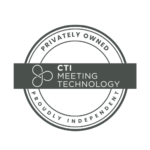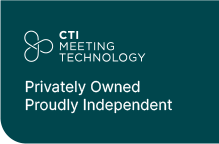For far too long, event planners have navigated the complicated landscape of meeting management with numerous tools. You’re probably familiar with the juggling act: separate platforms for every meeting phase, complicated communication with stakeholders, managing multiple vendors, etc.
A software stack is not just a buzzword but a fundamental shift in producing successful events. Think of it as a carefully curated group of software tools, each with a specific purpose to handle one aspect of meeting planning, seamlessly integrated to function as a cohesive whole.
Opposite to generic software, a well-designed stack streamlines critical conference planning workflows, minimizing errors, enhancing coordination, and providing a centralized data area. All of this sounds great, but how do you build a software stack that works – and is it essential to your meetings?
Why Build a Software Stack?
Let’s be honest: juggling multiple software providers can sometimes feel like building a mismatched Lego set – difficulties in transferring data, endless integrations needed, and frustration from attendees navigating several tools.
Now, add to that the sheer volume of abstract submissions and presentations that you and your team have to manage and the logistics of creating a successful program schedule, and everything is bound to go wrong. By building an effective software stack for your scientific conference, these specialized tools address the most demanding aspects of the planning process.
This guide will walk you through the essential components of a successful conference software stack, focusing on the core pillars of abstract, presentation, and program management. We’ll explore the key features to look for and provide a framework for choosing the right tools to build your own conference tech powerhouse.
Abstract Management: Curating The Meeting Content
Abstracts are undeniably the heart of any research-focused conference. That’s why the abstract collection and reviewing phases set the stage for the quality and relevance of the overall program. Working with dedicated abstract management software provides a structured and efficient platform for the entire submission lifecycle. This isn’t just about collecting documents but implementing rigorous review processes, facilitating communication with submitters, and ultimately curating compelling content for your sessions.
When evaluating abstract management software providers, prioritize key features that will streamline your workflows and enhance the quality of your review process:
- Customizable submission forms: Ensure you can tailor forms to your specific requirements and data fields to gather all the information you need from submitters.
- Efficient and fair reviewer assignment tools: Look for features that allow you to assign reviewers based on their expertise, manage workload, and track review progress effectively.
- Automated notifications: Keep submitters informed at every stage, from submission confirmation to acceptance or rejection, reducing administrative burden and improving communication.
- Robust reporting capabilities: Gain valuable insights into the submission status, reviewer performance, and overall quality of the submitted abstracts through comprehensive reporting features.
Presentation Management: Delivering Knowledge Seamlessly
While abstracts are the base of an interesting meeting, ensuring effective knowledge-sharing hinges on reliable presentation management. Forget the logistical nightmares of last-minute USB drives, incompatible file formats, and the stress of organizing speaker materials. A dedicated presentation management system offers a secure, centralized, and organized platform for speakers to upload their presentations well before sessions.
Essential features to look for include:
- Version control: Maintain clarity and prevent using outdated files by tracking different versions of presentations.
- Dedicated speaker portal: Provide speakers with an intuitive and user-friendly interface for uploading and managing their presentation materials.
- Session builder integration: Seamlessly link presentations to specific sessions within your program, ensuring accurate information is displayed to attendees.
- Mobile access for presenters: Empower speakers to review their materials anytime, from any device, providing convenience and peace of mind.
Program Management: Managing the Attendee Experience
Once the content is ready, crafting a compelling event program is crucial. Randomly arranging sessions is a recipe for disaster, causing attendees to lose interest and giving your team headaches. Logistically, you need to consider speaker and room availability – but crafting an interesting agenda that keeps attendees engaged throughout the meeting can be challenging. This goes beyond simple scheduling; you want to create a dynamic, engaging attendee experience.
When evaluating program management software, prioritize features that empower you to build a dynamic and well-organized program:
- Intuitive scheduling interfaces: Look for user-friendly, drag-and-drop interfaces that simplify processes like assigning sessions to rooms and time slots.
- Automatic conflict detection: Prevent frustrating logistical clashes such as double-booked speakers or overlapping sessions with automated conflict detection features.
- Comprehensive communication and information tracking tools: Facilitate seamless communication with speakers and track essential information related to their participation.
- Real-time scheduling updates and personalized agendas: Ensure attendees have access to the most up-to-date program information, often through seamless integration with event mobile apps, allowing them to create custom agendas.
Choosing the Right Tools
Beyond the specific functionalities of abstract, presentation, and program management software, selecting the right tools for your overall conference planning stack demands a strategic and data-informed approach. Forget about the latest trends or the flashiest tools, and be honest about your needs and objectives.
Consider these critical criteria during your selection process:
- Features and Functionality: Begin with a thorough needs assessment. What are your must-have features for abstract, presentation, and program management? Don’t be swayed by extraneous functionalities inconsistent with your core planning requirements. Prioritize tools offering robust and intuitive features directly relevant to your conference format and complexity.
- Scalability: Look to the future. Will the software accommodate the anticipated growth of your conference? Consider factors like the number of expected submissions, the complexity of the program, and the potential increase in attendees. Choosing scalable tools will save you the headache of migrating to a new system later.
- User-Friendliness: Clunky or unintuitive software can hinder productivity and frustrate your planning team and end-users. Opt for tools with clean, intuitive interfaces and readily available, comprehensive training resources. Ease of use drives adoption and maximizes efficiency across the board.
- Security and Reliability: In an era of increasing data privacy concerns, robust security measures are non-negotiable. Research vendors thoroughly to ensure they adhere to industry best practices for data protection. Similarly, the reliability of the software is critical for uninterrupted operations, especially during the high-pressure environment of the live conference.
- Support and Training: Last-minute challenges are a reality, so the quality of vendor support can be a significant differentiator. Evaluate the availability and responsiveness of their support team and the quality of their training materials and onboarding processes. Reliable support can be invaluable when troubleshooting issues or implementing new features.
- Cost and Value: While budget is a consideration, focus on the long-term value proposition. Consider the time savings, reduced errors, and enhanced efficiency the right software can deliver. A slightly more expensive tool with superior features and support may offer a better return on investment in the long run.
- Integration Capabilities: Seamless integration between your chosen tools is crucial for a cohesive and efficient workflow. Investigate the available integration options and ensure compatibility with other event technology solutions you may be using, such as registration platforms, CRM systems, and marketing automation software. Smooth data flow between systems eliminates silos, reduces manual data entry, and streamlines overall workflows.
Integration vs All-In-One Solutions
Every meeting is different, and so is the technology most suitable to manage it. A critical decision you’ll face is whether to assemble your software stack with tools from multiple providers or to invest in an all-in-one solution that encompasses most, if not all, of your conference planning needs.
Opting for integrated tools provides the flexibility to handpick specialized software that excels in each specific component of conference management. This allows you to leverage cutting-edge features tailored to your exact needs. However, this approach necessitates careful consideration of integration capabilities and the potential for managing multiple vendor relationships.
All-in-one platforms present the allure of simplicity, with all essential features for meeting planning included in a single, unified system. This can streamline setup and simplify data flow. However, all-in-one solutions may sometimes lack the depth and sophistication of specialized features found in state-of-the-art technology, and you might encounter limitations or vendor lock-in as your conference needs evolve.
Ultimately, making the right choice depends on assessing your specific conference planning requirements, budget, and long-term strategic goals.
About cOASIS
At CTI Meeting Technology, our experience spans over four decades, collaborating with numerous associations with diverse and evolving needs. This deep understanding has driven the development of cOASIS, our comprehensive meeting management software solution for effective conference planning.
Whether you only need a few tools to support your meetings, our software offers integration capabilities to seamlessly integrate with the rest of your event management tools. If your workflow is more complex, opt for our all-in-one solution, which helps you manage from the beginning until post-event with cOASIS.
To make the choice even easier, we have developed comprehensive and easy-to-implement meeting templates that adapt to your needs. Explore the options and take the quiz to discover which meeting package is right for you.
Wrapping Up…
As you can see, a strategically chosen software stack is no longer a mere convenience – it’s the backbone of your meeting’s efficiency and success. By carefully selecting tools that seamlessly manage abstracts, streamline presentations, and orchestrate your program, you empower your team to focus on the strategic aspects of your conference, ultimately delivering a more impactful and memorable experience for your attendees.
Remember to prioritize seamless integration, intuitive user interfaces, and robust scalability. The right event technology solutions are the key to managing the complexities of conference management and delivering outstanding events that achieve your strategic objectives.






